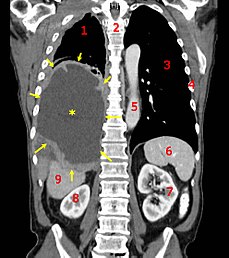| Cancer | |
|---|---|
| Classification and external resources | |
 A coronal CT scan showing a cancer of rightpleural membranes, the outer surface of the lung and inner surface of the chest wall, malignant mesothelioma Legend: → tumor ←, ★ central pleural effusion, 1 & 3 lungs, 2 spine, 4 ribs, 5 aorta, 6 spleen, 7 & 8 kidneys, 9 liver. | |
| ICD-10 | D00. |
| ICD-9 | 140—239 |
| DiseasesDB | 28843 |
| MedlinePlus | 001289 |
| MeSH | D009369 |
Cancer /ˈkænsər/ (![]() listen), medically called a malignant neoplasm, is a term for a large group of different diseases. In cancer, cells divide and grow uncontrollably, forming malignant tumors, and invade nearby parts of the body. The cancer may also spread to more distant parts of the body through the lymphatic system orbloodstream. Not all tumors are cancerous. Benign tumors do not grow uncontrollably, do not invade neighbouring tissues, and do not spread through the body.
listen), medically called a malignant neoplasm, is a term for a large group of different diseases. In cancer, cells divide and grow uncontrollably, forming malignant tumors, and invade nearby parts of the body. The cancer may also spread to more distant parts of the body through the lymphatic system orbloodstream. Not all tumors are cancerous. Benign tumors do not grow uncontrollably, do not invade neighbouring tissues, and do not spread through the body.
Healthy cells control their own growth and will destroy themselves if they become unhealthy. Cell division is a complex process that is normally tightly regulated. Cancer happens when problems in the genes in a cell prevent these controls from working. These problems with genes may be from damage to the gene or may be inherited. Damage to genes can come from many sources inside or outside of the cell. Faults in two types of genes are especially important: oncogenes, which drive the growth of cancer cells, and tumor suppressor genes, which prevent cancer from developing.
Determining what causes cancer is complex, and it is often impossible to assign a specific cause for a specific cancer. Many things are known to increase the risk of cancer including tobacco use, infection, radiation, lack of physical activity, poor diet and obesity, and environmental pollutants.[1] These can directly damage genes or combine with existing genetic faults within cells to cause the disease.[2] A small percentage of cancers, approximately five to ten percent, are entirely hereditary.
Cancer can be detected in a number of ways, including the presence of certain signs and symptoms, screening tests, or medical imaging. Once a possible cancer is detected it is diagnosed by microscopic examination of a tissue sample. Cancer is usually treated with chemotherapy, radiation therapy and surgery. The chances of surviving the disease vary greatly by the type and location of the cancer and the extent of disease at the start of treatment. While cancer can affect people of all ages, and a few types of cancer are more common in children, the risk of developing cancer generally increases with age. In 2007, cancer caused about 13% of all human deaths worldwide (7.9 million). Rates are rising as more people live to an old age and as mass lifestyle changes occur in the developing world.[3]
Tidak ada komentar:
Posting Komentar